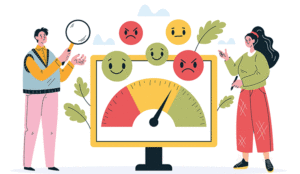Rachael Royds of CallMiner discusses how you can use analytics tools to undertake customer experience analysis.
A positive, engaging customer experience fosters customer loyalty and drives growth. In fact, 86% of customers say they’re willing to pay more for a better customer experience.
According to Walker’s Customers 2020 report, customer experience is poised to overtake price and product as the top brand differentiator.
But how do you know if your customer experience is checking all the boxes? That’s where a customer experience analysis comes in, offering insights on how consumers interact with your brand and the impact of those interactions on customers’ perceptions throughout the buyer’s journey.
Let’s take a closer look at how a customer experience analysis works and how to conduct a CX analysis.
Definition of Customer Experience Analysis
A customer experience analysis is any type of in-depth study evaluating how a customer (and potential customers) interact with a given brand. The analysis can include both direct contact and indirect contact with a brand. Direct contact would include interactions, at least in some ways, initiated by the company.
Direct contact examples include:
- Advertising (online, print and televised)
- Marketing (outreach, social media, SEO, content)
- Sales (cold email, calls, demos)
- Support (customer service, onboarding)
Indirect contact would be experiences customers have that a business did not initiate.
Examples of indirect contact include:
- Brand mentions (particularly on social media)
- Reviews (both on dedicated review sites and individual reviews)
- Word-of-mouth (what customers are saying about the brand)
Benefits of Performing a Customer Experience Analysis
For many organizations, customer acquisition is a simple process. Leads or traffic come in from a limited number of channels. Those potential customers are funneled through a specific sales process.
Other companies can have an intricate and complex system for getting and closing customers. Regardless of where your company may be on that spectrum, a customer experience analysis offers several benefits.
- Snapshot of Processes: Regardless of the complexity of your acquisition approach, having a detailed look at how customers interact with your brand is a very useful tool. Training new team members and delegating responsibilities more effectively are just two of the many ways a snapshot can benefit an organization.
- Easy-to-See Vulnerabilities: Having a visual look at how people see and interact with your business often makes any opportunities stand out. Once seen, these potential problems can be quickly fixed. For instance, if you don’t have a Twitter profile, yet customers are talking about your business there — a plan can be enacted quickly.
- Discover New Possibilities: New acquisition channels, improved brand awareness and other positive opportunities can be seen in a quality analysis. An example would be a high conversion rate of leads who find your brand via social media, even with minimal investment. In this case, your CX analysis informs the decision to increase your social media marketing efforts with the goal of boosting revenue.
Developing a Customer Experience Analysis Strategy
The process of finding and analysing all the ways customers interact with your business can seem daunting. While it can take some time, evaluating the customer experience doesn’t have to be a top-to-bottom endeavour.
The entire process can be done in stages, or simply review a single portion of the business. A smaller section of the customer experience could be considered a “specific” customer experience analysis.
Examples of a Specific Customer Experience Analysis
- Social Media: Knowing where your customers are (and how they’re talking to/about you) is important.
- Website: Checking the most popular pages, testing elements to see which ones are working and evaluating metrics (time on site, bounce rate, etc.) are valuable for a site check.
- Marketing: From emails you send to ads you take out. All forms of marketing displayed for you to see is a great way to check efficiency.
- Sales: Once a lead becomes sales-qualified until they are either won or lost.
- Support: All interactions and communications after sales. This would include both interactions with products and with you (for instance follow-up emails).
- Competition: You can do a specific or in-depth analysis of any of your competitors, too. While you won’t be privy to private data, there is a large amount of data publicly available.
An In-Depth Analysis (All or Most of the Above)
An in-depth analysis may include every interaction measured in one place, or it may consist a series of specific evaluations. For instance, if you’re converting a large percentage of leads but aren’t seeing enough leads in your pipeline — an analysis of everything leading up to the sales process would be helpful.
How to Complete a Customer Experience Analysis in 3 Steps
STEP 1 – List Interaction Points
Once you’ve decided on a strategy, it’s time to list out all of the known interaction points to be evaluated. Be as thorough as possible and write down every possible avenue. The data-gathering process will quickly bear out whether it is an actual interaction point.
STEP 2 – Gather and Assimilate Data
Once you have all potential interaction points, it’s time to actually see how (and how often) customers see your brand in each. Collection can be done in a number of ways and largely depends on the type of analysis.
Here are several broad tools to use for data-gathering:
Website Analytics Tools: Analytics tools include heatmaps, social tools, Google Analytics, and many more.
Speech Analytics Tools: A speech analytics solution like CallMiner Eureka scores 100% of your customer interactions, providing a rich source of unsolicited feedback across channels, including both the Voice of the Customer (VOC) and the Voice of Your Employees (VOE) to increase sales effectiveness, boost customer loyalty, and more.
Surveys: Things like polls on Facebook/Twitter or tools like SurveyMonkey can be employed to solicit customer feedback and measure metrics like Net Promoter Score (NPS).
Conversations: Actually talking with current and past customers can yield some of the best data available for analysis.
Once as much data as possible has been gathered, it’s time to put it all in a readable (even visual) format. Creating reports that all pertinent team members can quickly understand will ensure usefulness.
STEP3 – Analyse Data and Take Action
The final step is to take action on the insights gained from your customer experience analysis. Once completed, reports should yield all the aforementioned benefits. Opportunities should be clear, allowing you to implement changes and improve processes quickly.
The biggest mistake you could make once your analysis is complete is failing to act on your findings.
This blog post has been re-published by kind permission of CallMiner – View the Original Article
For more information about CallMiner - visit the CallMiner Website
Call Centre Helper is not responsible for the content of these guest blog posts. The opinions expressed in this article are those of the author, and do not necessarily reflect those of Call Centre Helper.
Author: CallMiner
Published On: 11th Jul 2019 - Last modified: 16th Jul 2019
Read more about - Guest Blogs, CallMiner






 CallMiner is the leading cloud-based customer interaction analytics solution for extracting business intelligence and improving agent performance across all contact channels.
CallMiner is the leading cloud-based customer interaction analytics solution for extracting business intelligence and improving agent performance across all contact channels. 

































